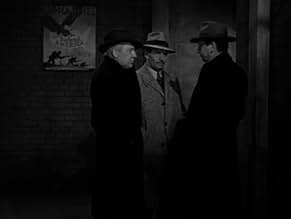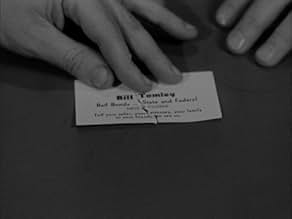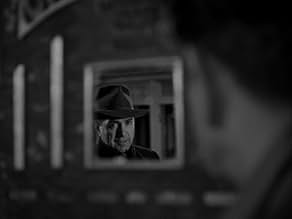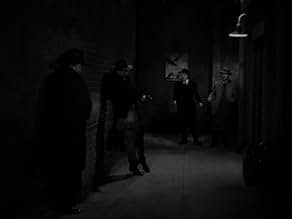IMDb रेटिंग
6.3/10
1.3 हज़ार
आपकी रेटिंग
अपनी भाषा में प्लॉट जोड़ेंA depressed man hires an assassin to kill him when he least expects it, but when his life takes an upward turn, he finds he now wishes to live.A depressed man hires an assassin to kill him when he least expects it, but when his life takes an upward turn, he finds he now wishes to live.A depressed man hires an assassin to kill him when he least expects it, but when his life takes an upward turn, he finds he now wishes to live.
Trevor Bardette
- The Bum in the Next Bed
- (बिना क्रेडिट के)
William 'Billy' Benedict
- The Deafmute
- (बिना क्रेडिट के)
Willie Bloom
- Bum
- (बिना क्रेडिट के)
Roy Brent
- Detective in Alley
- (बिना क्रेडिट के)
Charles Coleman
- Jennings the Butler
- (बिना क्रेडिट के)
Clancy Cooper
- Telephone Repairman
- (बिना क्रेडिट के)
Don Costello
- Lefty Vigran aka Gorss
- (बिना क्रेडिट के)
Russell Custer
- Bar Patron
- (बिना क्रेडिट के)
Ralph Dunn
- Cop at Car Accident
- (बिना क्रेडिट के)
Otto Forrest
- The Whistler
- (बिना क्रेडिट के)
Byron Foulger
- Flophouse Desk Clerk
- (बिना क्रेडिट के)
John George
- Bum
- (बिना क्रेडिट के)
Dick Gordon
- Tomley's Assistant
- (बिना क्रेडिट के)
Robert Homans
- Dock Watchman
- (बिना क्रेडिट के)
फ़ीचर्ड समीक्षाएं
This unusual Film Noir (the only one ever to be made into a whole series of films) certainly catches the sinister atmosphere of its genre, both visually with very well done shadow effects and the adequate 'cheap' harbor surroundings of a B movie, and thematically, using a lot of psychology which doesn't fail to have its effects, neither on the protagonists nor on the audience - but just a little bit of an overdose of the belief in 'destiny'...
Whose destiny is it to live or to die? Who has a 'right' to live or to die? Questions like these are maybe somehow out of place in a Film Noir - because they've got too much to do with morality. The Noir world (at least that of the 40s) is usually quite immoral (see "The Maltese Falcon", "The Shanghai Gesture", "Gilda"); and it's not always the good ones who get away - that's the cynical Noir philosophy...
But anyway, "The Whistler" still remains an enormously suspenseful film with a very capable cast and direction; and a 'must' for every fan of classic crime.
Whose destiny is it to live or to die? Who has a 'right' to live or to die? Questions like these are maybe somehow out of place in a Film Noir - because they've got too much to do with morality. The Noir world (at least that of the 40s) is usually quite immoral (see "The Maltese Falcon", "The Shanghai Gesture", "Gilda"); and it's not always the good ones who get away - that's the cynical Noir philosophy...
But anyway, "The Whistler" still remains an enormously suspenseful film with a very capable cast and direction; and a 'must' for every fan of classic crime.
I watched this last night on TCM and found it not only thoroughly entertaining but a textbook example of how a B-grade picture from a poverty row studio could rise above its budget limitations thanks to the efforts of a clever director (William Castle) and strong players (Richard Dix and J. Carroll Naish in particular). Superior in some respects to entries in parallel series based on radio programs (like Universal's Inner Sanctum with Lon Chaney, Jr.), perhaps the most appealing aspect of "The Whistler" is the economy with which the story is told. There are no needless lines, no needless scenes. Whether it belongs within the "noir" cycle is a matter to be debated, but nevertheless "The Whistler" has its share of the quirky characters and shadowy settings that typify that genre, not to mention the creepy portrayal by Naish of a hit-man who reads a monograph on "necrophobia" in his spare time.
This movie is the first installment of The Whistler series from Columbia Pictures, all but one of which starred Richard Dix whose A-picture career was then on an alcoholic downgrade, but whose liquor-ravaged face was just right for the overall atmosphere. (For a complete list of series titles, consult "movie connections" on web page.) Of all the movie series to emerge from the 30's and 40's, this is easily one of the most fascinating and unusual. Each entry presents a different self-contained story, tied together only by the mysterious figure of The Whistler who comments briefly on plot developments, but appears only in shadow to whistle his trademark refrain. He seems to be a figure of fate since the hand of destiny emerges in most of the entries. But most importantly, the plots follow no formula (unusual for any series) and are entirely unpredictable in their outcome. This unpredictability is what distinguishes the series from others of the time.You really don't know what's going to happen or how each episode will turn out. Moreover, there's a strong noirish quality to many of the entries, with a suspenseful atmosphere, an underlying sense of doom, and imaginative characters and plot twists. All in all, the productions are a first cousin to the celebrated Val Lewton horror cycle from RKO, minus the supernatural. I'm surprised that with all the scholarly interest in film noir, that this noirish series has not received the critical attention it merits.
Though weaker in many ways (the script appears put together on the fly), this initial entry contains many features generic to the others. Dix, a prosperous manufacturer, arranges for his own death following the presumed death of his beloved wife, only to find out ironically that she is not dead. The problem is he can't undo the arrangement and is thus forced to escape through the labyrinthine venues of the city's skid row. The entire 60 minutes has something of a nightmarish quality since it starts off with Dix expecting death, though in what form, he can't be sure. Looking convincingly like a real bum, it's Dix's tour through the seedy parts of the city that really commands attention, especially the 25-cent flop-house with its rows of coffin-like cots, snoring vagrants, and sneak thief. You can almost smell the rot-gut whiskey peeling off the walls. The sets are bare-bones, the cafes, bars, and city sidewalks sometimes suggesting the unadorned depths of urban despair. Unfortunately, the ending is abrupt and disappointing. It's almost as though the production suddenly ran out of film and had to wrap it up right then. Nonetheless, many of the distinctive elements of the productions are already present. Unfortunately copies of the series are hard to obtain ( my own burned in a house fire some time ago). So let's hope our friends on cable TV follow up on this initial entry some time soon. It's well worth tuning in.
Though weaker in many ways (the script appears put together on the fly), this initial entry contains many features generic to the others. Dix, a prosperous manufacturer, arranges for his own death following the presumed death of his beloved wife, only to find out ironically that she is not dead. The problem is he can't undo the arrangement and is thus forced to escape through the labyrinthine venues of the city's skid row. The entire 60 minutes has something of a nightmarish quality since it starts off with Dix expecting death, though in what form, he can't be sure. Looking convincingly like a real bum, it's Dix's tour through the seedy parts of the city that really commands attention, especially the 25-cent flop-house with its rows of coffin-like cots, snoring vagrants, and sneak thief. You can almost smell the rot-gut whiskey peeling off the walls. The sets are bare-bones, the cafes, bars, and city sidewalks sometimes suggesting the unadorned depths of urban despair. Unfortunately, the ending is abrupt and disappointing. It's almost as though the production suddenly ran out of film and had to wrap it up right then. Nonetheless, many of the distinctive elements of the productions are already present. Unfortunately copies of the series are hard to obtain ( my own burned in a house fire some time ago). So let's hope our friends on cable TV follow up on this initial entry some time soon. It's well worth tuning in.
Fans of the radio series will not be dissapointed by this little gem of a thriller. Richard Dix gives a great performance as a man who puts a contract out on his own life. He is upset because he has not gotten over his wife drowning in the Pacific Ocean on a vacation three years ago. He then gets a wire saying his wife is alive, will be home soon, and now has to hurry and stop the contract. The only thing this was missing that was common in the radio play was a suprise ending. Very often in the radio series, it was never a question of whodunit, as it was often told through the killer's point of view, but it was how they were going to trip themselves up or get caught. And it was always with a twist.
Whistler, The (1944)
** 1/2 (out of 4)
First film in Columbia's series has Richard Dix playing a man wanting to commit suicide due to the death of his wife but he doesn't have the courage to do so. Wanting to die, Dix hires a killer (J. Carrol Naish) to do the job but then he learns that his wife is still alive so he too must try and stay alive. Based on a radio show, this first film is actually pretty entertaining due to some nice direction by Castle and the two leads turning in fine performances. The story itself is pretty interesting and the B-budget gets all out of it that it can. Dix makes for a very good leading man and his performance is very good especially during his depression scenes. Naish is a great character actor and makes for a very good killer. Gloria Stuart plays Dix secretary and does nice work, although she has the weakest character.
** 1/2 (out of 4)
First film in Columbia's series has Richard Dix playing a man wanting to commit suicide due to the death of his wife but he doesn't have the courage to do so. Wanting to die, Dix hires a killer (J. Carrol Naish) to do the job but then he learns that his wife is still alive so he too must try and stay alive. Based on a radio show, this first film is actually pretty entertaining due to some nice direction by Castle and the two leads turning in fine performances. The story itself is pretty interesting and the B-budget gets all out of it that it can. Dix makes for a very good leading man and his performance is very good especially during his depression scenes. Naish is a great character actor and makes for a very good killer. Gloria Stuart plays Dix secretary and does nice work, although she has the weakest character.
क्या आपको पता है
- ट्रिवियाFirst of eight entries in the "Whistler" series, released from 1944 to 1948, and Richard Dix appeared in all but the last one. Unusually, he played a different character in each.
- गूफ़While the killer is lying on the bed perusing his book on Fear of Death, a cigarette suddenly appears in his mouth.
- भाव
The Bum in the Next Bed: Rats in this place as big as beavers. They won't hurt ya... but you're liable to trip over them in the dark.
- कनेक्शनFeatured in Spine Tingler! The William Castle Story (2007)
टॉप पसंद
रेटिंग देने के लिए साइन-इन करें और वैयक्तिकृत सुझावों के लिए वॉचलिस्ट करें
विवरण
- रिलीज़ की तारीख़
- कंट्री ऑफ़ ओरिजिन
- भाषा
- इस रूप में भी जाना जाता है
- Der Whistler
- फ़िल्माने की जगहें
- उत्पादन कंपनी
- IMDbPro पर और कंपनी क्रेडिट देखें
- चलने की अवधि59 मिनट
- रंग
- पक्ष अनुपात
- 1.37 : 1
इस पेज में योगदान दें
किसी बदलाव का सुझाव दें या अनुपलब्ध कॉन्टेंट जोड़ें


































